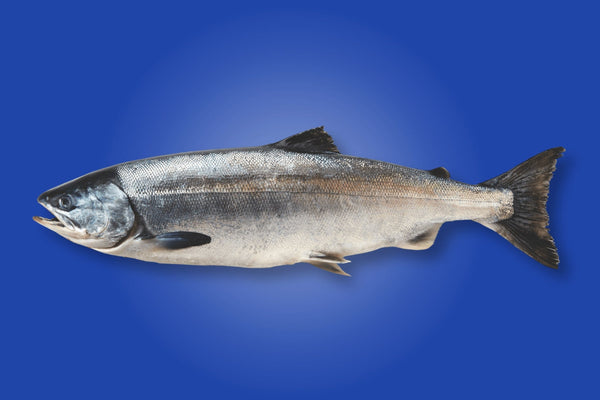Keta Salmon: Everything You Need to Know
Updated on Jul 10, 2023
Alaskan keta salmon, also known as chum salmon, is a remarkable species revered for its abundance and culinary versatility. Found in the pristine waters of Alaska, this distinct salmon variety captivates seafood enthusiasts with its firm, pale pink flesh and delicate flavor profile.
If you’re keen on introducing keta salmon into your kitchen routine, this article is for you! Learn how keta salmon looks and tastes and what benefits it offers.
What is Keta Salmon?
Keta salmon, also known as chum salmon or dog salmon, is a species of fish that belongs to the Salmonidae family. Its scientific name is Oncorhynchus keta. Keta salmon are native to the northern Pacific Ocean, particularly in the coastal waters of North America and Asia.
Keta Salmon Appearance
Keta salmon are generally large fish, with adults ranging from 8 to 20 pounds (3.6 to 9 kg).
Colors vary depending on life stage. When in the ocean, they have a metallic greenish-blue back, silver sides, and a white belly. During the spawning season, they develop darker hues, with olive-green or maroon patches on their sides, giving them a mottled or blotchy appearance.
As for their body shape, keta salmon are streamlined with a slightly elongated body, tapering towards the tail. They are relatively slender compared to some other salmon species.
Keta salmon also have an adipose fin, a small fleshy fin located between the dorsal fin and the tail. Additionally, they have a dorsal fin, pectoral fins, pelvic fins, and an anal fin, all of which help them maneuver in the water.
Finally, keta salmon have sharp, well-developed teeth. During the spawning season, males use these teeth to fight for mates and defend their spawning territories.

Keto Salmon Nutrition
Keta salmon, like other salmon species, is known for its nutritional value. Here is some information about the nutrition content of keta salmon per 100 grams (3.5 ounces) of cooked fish [* (opens in a new window)]:
- Calories: Approximately 120 calories
- Protein: About 20 grams
- Fat: Around 3.8 grams
- Saturated fat: Approximately 0.8 grams
- Cholesterol: Approximately 74 milligrams
Keta Salmon Harvesting & Seasonality
Keta salmon have specific seasons and methods for harvesting. They have distinct seasonal runs when they return from the ocean to their natal rivers to spawn. The timing of these runs can vary depending on the region, but generally, keta salmon runs occur from late spring to early autumn.
Keta salmon are harvested through various methods, including commercial fishing, sport fishing, and subsistence fishing. The specific methods can vary depending on the location and regulations in place. Commercial fishermen often use gillnets, purse seines, or drift nets to catch keta salmon. Sport fishermen may use fishing rods and reels or fly fishing techniques.
Keta Salmon Sustainability & Environment
The International Union for Conservation of Nature (IUCN) currently classifies keta salmon as a species of least concern in terms of conservation status. However, it's essential to monitor and manage their populations to ensure their long-term sustainability, as keta salmon transport nutrients from the ocean to freshwater systems, contributing to the fertility of rivers and surrounding habitats. They also serve as a food source for various predators, contributing to the biodiversity and ecological balance of their habitats.
Fisheries management authorities and organizations implement regulations and quotas to maintain sustainable harvesting levels of keta salmon. These measures prevent overfishing and protect the overall population and ecosystem health.
Protecting the spawning and rearing habitats of keta salmon is crucial for their survival and overall ecosystem health. Preserving and restoring river systems, wetlands, and coastal areas that are essential for their lifecycle is vital to maintain sustainable populations.
Another concern in keta fishing practices is bycatch, the unintentional capture of non-target species during fishing operations. Implementing measures to minimize bycatch, such as using selective fishing gear and avoiding sensitive areas, reduces the impact on non-target species and ecosystem balance.
Perhaps the most significant challenge keta salmon face is climate change, affecting water temperature, ocean currents, and food availability. Monitoring the impacts of climate change on keta salmon and implementing adaptive management strategies are crucial for their long-term sustainability.
What is the Best Way to Cook Keta Salmon?
Keta salmon boasts lean yet dense meat, cooked best under lower temperatures. You’ll find the best keta salmon recipes are baked, broiled, grilled, poached, roasted, or steamed. You can even enjoy keta salmon raw.
Try out these fantastic Alaskan keta salmon recipes:
Keta Salmon Fun Facts
- Keta salmon are known for their remarkable homing instinct. After spending several years at sea, they navigate back to their exact birthplace, often traveling hundreds or even thousands of miles, to spawn in the same river or stream where they were born.
- When male keta salmon spawn, they develop a beak or kype that bears fangs.
- Depending on when they return to spawn, keta salmon belong to two distinct races: summer and fall chum.
Summary
Keta salmon stands as a testament to the rich biodiversity and culinary treasures found in the waters of Alaska. Its plentiful availability, distinct flavor, and versatility in the kitchen make it a popular choice among seafood lovers. Whether enjoyed grilled, baked, or in sushi, Alaskan keta salmon offers a delectable experience that embodies the natural splendor and gastronomic delights of this pristine region.
If you're after the finest salmon, our wild sockeye salmon and wild king salmon are excellent choices. From Alaska's pristine waters, this premium fish combines rich flavor with outstanding nutrition!








